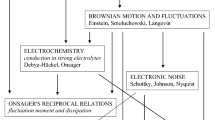Abstract
Within the framework of the Einstein fluctuation–dissipation relation, the theoretical analysis of the noise resistance is carried out for two classical electrochemical ac circuits: Ershler–Randles and Frumkin–Melik-Gaikazyan. It is shown that as the sampling period of the noise signal increases, the noise resistance in the Ershler–Randles circuit tends to its limiting value which coincides with the slow discharge resistance. The asymptotic behavior of the Frumkin–Melik-Gaikazyan circuit is of a different manner. As the sampling period of the noise signal increases, the curve of the noise resistance of the Frumkin–Melik-Gaikazyan circuit transforms into a straight line with the tangent inversely proportional to the thermodynamic capacitance of the electrode. The fluctuation–dissipation relation of Einstein may be used in the theoretical analysis of the noise resistance of other electrochemical ac circuits.





Similar content being viewed by others
REFERENCES
Bierwagen, G.P., Calculation of noise resistance from simultaneous electrochemical voltage and current noise data, J. Electrochem. Soc., 1994, vol. 141, p. L155.
Chen, J.F. and Bogaerts, W.F., The physical meaning of noise resistance, Corros. Sci., 1995, vol. 37, p. 1839.
Bertocci, U., Gabrielli, C., Huet, F., and Keddam, M., Noise resistance applied to corrosion measurements: I. Theoretical analysis, J. Electrochem. Soc., 1997, vol. 144, p. 31.
Bautista, A., Bertocci, U., and Huet, F., Noise resistance applied to corrosion measurements: V. Influence of electrode asymmetry, J. Electrochem. Soc., 2001, vol. 148, p. B412.
Cottis, R.A., Interpretation of electrochemical noise data, Corrosion, 2001, vol. 57, p. 265.
Lowe, A.M., Eren, H., and Bailey, S.I., Electrochemical noise analysis: detection of electrode asymmetry, Corros. Sci., 2003, vol. 45, p. 941.
Rivera, A.L. and Castaño, V.M., Corrosion analysis by electrochemical noise: A teaching approach, J. Mater. Educ., 2012, vol. 34, p. 5.
Jamali, S.S. and Mills, D.J., A critical review of electrochemical noise measurement as a tool for evaluation of organic coatings, Prog.Org. Coat., 2016, vol. 95, p. 26.
Tang, Y., Dai, N., Wu, J., Jiang, Y., and Li, J., Effect of surface roughness on pitting corrosion of 2205 duplex stainless steel investigated by electrochemical noise measurements, Materials, 2019, vol. 12, p. 738.
Obot, I.B., Onyeachu, I.B., Zeino, A., and Umoren, S.A., Electrochemical noise (EN) technique: review of recent practical applications to corrosion electrochemistry research, J. Adhes. Sci. Technol., 2019, vol. 33, p.1453.
Xia, D.H., Song, S., Behnamian, Y., Hu, W., Cheng, Y.F., Luo, J.L., and Huet, F., Review-Electrochemical noise applied in corrosion science: theoretical and mathematical models towards quantitative analysis, J. Electrochem. Soc., 2020, vol. 167, p. 081507.
Timashev, S.F., Generalization of fluctuation-dissipation relationships, Russ. J. Phys. Chem. A, 2005, vol. 79, no. 11, p. 1720.
Nyquist, H., Thermal agitation of electric charge in conductors, Phys. Rev., 1928, vol. 32, p. 110.
Johnson, J.B., Thermal agitation of electricity in conductors, Phys. Rev., 1928, vol. 32, p. 97.
Callen, H.B. and Welton, T.A., Irreversibility and generalized noise, Phys. Rev., 1951, vol. 83, p. 34.
Johnson, P.J., Clark, C.D., and Artus, R.G., The determination of electrical conductivity by thermal noise measurements, J. Phys. D: Appl. Phys., 1986, vol. 19, p. 835.
Gomila, G., Pennetta, C., Reggiani, L., Sampietro, M., Ferrari, G., and Bertuccio, G., Shot noise in linear macroscopic resistors, Phys. Rev. Lett., 2004, vol. 92, p. 226601.
Einstein, A., On the movement of small particles suspended in a stationary liquid demanded by the molecular-kinetic theory of heat, Ann. Phys., 1905, vol. 17, p. 549.
Einstein, A., Elementare theorie der brownschen bewegung, Z. Elektrochem. Angew. Phys. Chem. 1908 Apr 24, vol. 14(17), p. 235.
Coffey, W. and Kalmykov, Y.P., The Langevin Equation: with Applications to Stochastic Problems in Physics, Chemistry and Electrical Engineering, in World Scientific Series in Contemporary Chemical Physics, World Scientific, 2012, vol. 27.
Ershler, B.V., Investigation of electrode reactions by the method of charging-curves and with the aid of alternating currents, Disc. Faraday Soc., 1947, vol. 1, p. 269.
Randles, J.E.B., Kinetics of rapid electrode reactions, Disc. Farad. Soc., 1947, vol. 1, p. 11.
Frumkin, A.N. and Melik-Gaikazyan, V.I., Determination of the adsorption kinetics of organic substances based on ac measurements of the capacitance and conductivity of the electrode/solution interface, Dokl. Akad. Nauk SSSR, 1951, vol. 77, p. 855.
Bouchaud, J.P. and Georges, A., Anomalous diffusion in disordered media: statistical mechanisms, models and physical applications, Phys. Rep., 1990, vol. 195, p. 127.
Barkai, E. and Fleurov, V.N., Generalized Einstein relation: A stochastic modeling approach, Phys. Rev. E: Stat. Phys., Plasmas, Fluids, 1998, vol. 58, p. 1296.
Gradenigo, G., Sarracino, A., Villamaina, D., and Vulpiani, A., Einstein relation in superdiffusive systems, J. Stat. Mech.: Theory Exp., 2012, p. L06001.
Funding
This study was supported by the Ministry of Science and Higher Education of Russia.
Author information
Authors and Affiliations
Corresponding author
Ethics declarations
The authors declare that they have no conflict of interest.
Additional information
Translated by T. Safonova
A tribute to outstanding electrochemist Oleg Aleksandrovich Petrii (1937–2021).
Rights and permissions
About this article
Cite this article
Grafov, B.M., Klyuev, A.L. & Davydov, A.D. The Einstein Fluctuation–Dissipation Relation as Applied to the Analysis of the Electrochemical Noise Resistance. Russ J Electrochem 58, 725–729 (2022). https://doi.org/10.1134/S1023193522090063
Received:
Revised:
Accepted:
Published:
Issue Date:
DOI: https://doi.org/10.1134/S1023193522090063



